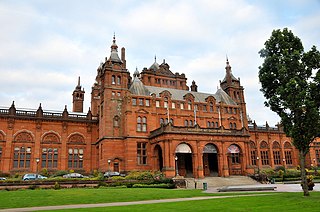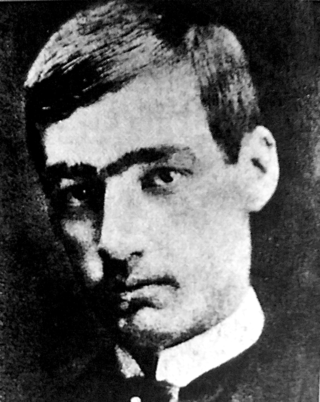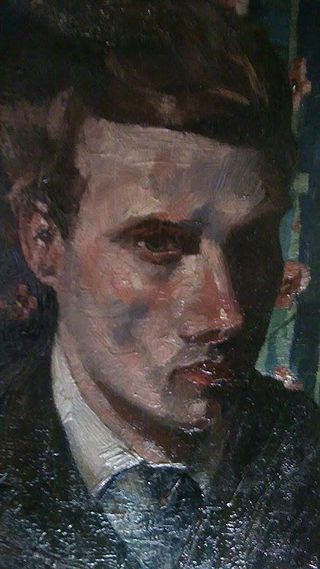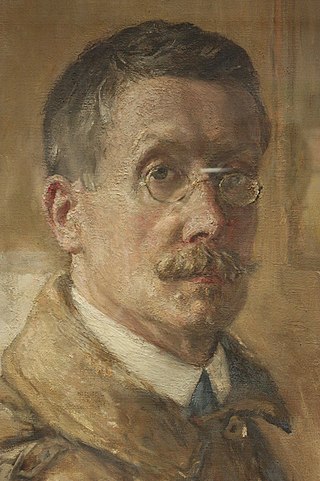
Kelvingrove Art Gallery and Museum is a museum and art gallery in Glasgow, Scotland, managed by Glasgow Museums. The building is located in Kelvingrove Park in the West End of the city, adjacent to Argyle Street. Kelvingrove Art Gallery and Museum is one of Scotland's most popular museums and free visitor attractions.

Kelvingrove Park is a public park located on the River Kelvin in the West End of the city of Glasgow, Scotland, containing the Kelvingrove Art Gallery and Museum.

John Patrick Byrne was a Scottish playwright, artist and designer. He wrote The Slab Boys Trilogy, plays which explore working-class life in Scotland, and the TV dramas Tutti Frutti and Your Cheatin' Heart. Byrne was also a painter, printmaker and theatre designer.

Sir William Reid Dick, was a Scottish sculptor known for his innovative stylisation of form in his monument sculptures and simplicity in his portraits. He became an Associate of the Royal Academy in 1921, and a Royal Academician in 1928. Dick served as president of the Royal Society of British Sculptors from 1933 to 1938. He was knighted by King George V in 1935. He was Sculptor in Ordinary for Scotland to King George VI from 1938 to 1952 then held the post under Queen Elizabeth until his death in 1961.

Benno Schotz was an Estonian-born Scottish sculptor, and one of twentieth century Scotland's leading artists.
The Glasgow School was a circle of influential artists and designers that began to coalesce in Glasgow, Scotland in the 1870s, and flourished from the 1890s to around 1910. Representative groups included The Four, the Glasgow Girls and the Glasgow Boys. Part of the international Art Nouveau movement, they were responsible for creating the distinctive Glasgow Style.

Joseph Crawhall was an English artist born in Morpeth, Northumberland.
The city of Glasgow, Scotland, has many amenities for a wide range of cultural activities, from curling to opera and from football to art appreciation; it also has a large selection of museums that include those devoted to transport, religion, and modern art. In 2009 Glasgow was awarded the title UNESCO Creative City of Music in recognition of its vibrant live music scene and its distinguished heritage. Glasgow has three major universities, each involved in creative and literary arts, and the city has the largest public reference library in Europe in the form of the Mitchell Library. Scotland's largest newspapers and national television and radio companies are based in the city.

Christ of Saint John of the Cross is a painting by Salvador Dalí made in 1951 which is in the collection of the Kelvingrove Art Gallery and Museum, Glasgow. It depicts Jesus Christ on the cross in a darkened sky floating over a body of water complete with a boat and fishermen. Although it is a depiction of the crucifixion, it is devoid of nails, blood, and a crown of thorns, because, according to Dalí, he was convinced by a dream that these features would mar his depiction of Christ. Also in a dream, the importance of depicting Christ in the extreme angle evident in the painting was revealed to him.

John Quinton Pringle was a Scottish painter, influenced by Jules Bastien-Lepage and associated with the Glasgow Boys.

Le Moulin de la Galette is the title of several paintings made by Vincent van Gogh in 1886 of a windmill, the Moulin de la Galette, which was near Van Gogh and his brother Theo's apartment in Montmartre. The owners of the windmill maximized the view on the butte overlooking Paris, creating a terrace for viewing and a dance hall for entertainment.

Norah Neilson Gray was a Scottish artist of the Glasgow School. She first exhibited at the Royal Academy while still a student and then showed works regularly at the Paris Salon and with the Royal Academy of Scotland. She was a member of The Glasgow Girls whose paintings were exhibited in Kirkcudbright during July and August 2010.

William Leiper FRIBA RSA (1839–1916) was a Scottish architect known particularly for his domestic architecture in and around the town of Helensburgh. In addition, he produced a small amount of fine ecclesiastical and commercial architecture in Glasgow and the Scottish Lowlands. He was also an accomplished watercolour artist, and from the late 1870s spent much spare time painting in oils and watercolours.

Art in modern Scotland includes all aspects of the visual arts in the country since the beginning of the twentieth century. In the early twentieth century, the art scene was dominated by the work of the members of the Glasgow School known as the Four, led by Charles Rennie Mackintosh, who gained an international reputation for their combination of Celtic revival, Art and Crafts and Art Nouveau. They were followed by the Scottish Colourists and the Edinburgh School. There was a growing interest in forms of Modernism, with William Johnstone helping to develop the concept of a Scottish Renaissance. In the post-war period, major artists, including John Bellany and Alexander Moffat, pursued a strand of "Scottish realism". Moffat's influence can be seen in the work of the "new Glasgow Boys" from the late twentieth century. In the twenty-first century Scotland has continued to produce influential artists such as Douglas Gordon and Susan Philipsz.

Alexander Ignatius Roche RSA NEAC RP was a Scottish artist in the late 19th century and an important figure in the "Glasgow Boys".

Elizabeth MacNicol (1869–1904) was a Scottish painter and member of the Glasgow Girls group of artists affiliated with the Glasgow School of artists.
Lawrie & Co. was an art dealership and gallery in London, England.
James Connell & Sons was an art gallery business and publisher of etchings in Glasgow and London. It was established by James Hodge Connell who retired in 1908, leaving the business to his sons James D. Connell, Thomas Connell, and David Connell. Dealing mainly in etchings and works on paper, artists whose work was sold through the gallery included: Andrew Affleck, Eugene Bejot, David Young Cameron, Hester Frood, Gertrude Ellen Hayes, Henry Rushbury, Nathaniel Sparks, Alfred W. Strutt, Edward Millington Synge, William Walker (engraver), Ernest Herbert Whydale and Mary G. W. Wilson.















